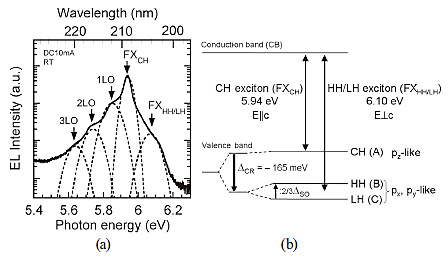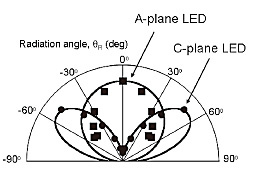Materials Science Laboratory
Aluminum nitride (AlN) is a direct-bandgap semiconductor with a bandgap
energy of 6 eV, the largest among semiconductors. Therefore, AlN is a promising
material for deep-ultraviolet (deep-UV) light-emitting devices with an
ultrashort wavelength. Previously, we achieved both n-type and p-type doping
in AlN and fabricated an AlN p-n junction light-emitting diode (LED) with
near-band-edge electroluminescence (EL) at a wavelength of 210 nm, the
shortest ever reported for any kind of LED [1]. Here we identify the origin
of the near-band-edge emission and propose a high-efficiency LED structure
based on the unique characteristic that the emission intensity largely
changes depending on the crystal planes of its surface.
First, a C-plane AlN p-n junction LED structure was grown on C-plane SiC substrate by metalorganic vapor phase epitaxy. By increasing the NH3 flow rate, the hole concentration in the p-type AlN was increased because of the suppressed formation of N vacancies, which act as compensating donors. As a result, the LED external quantum efficiency was increased from 8×10-6 to 1×10-4 % [2]. As shown in Fig. 1, the near-band-edge emission was dominated by
an exciton emission originating from the crystal-field split-off valence
band (FXCH), but another exciton emission originating from heavy/light hole valence
bands (FXHH/LH) was also observed. From the emission energies, considering residual strain,
the crystal-field splitting energy ΔCR was determined to be -165 meV. Because of the negative ΔCR, the topmost valence band is the crystal-field split off valence band
with a pZ-like state and then the near-band-edge emission polarizes for the electric
field parallel to the c-axis (E||c). Consequently, the near-band-edge emission
is weak from the C-plane but strong from the A-plane for AlN.
For nitride semiconductors, like AlN and GaN, the C-plane is preferable
for high-quality growth and therefore a C-plane LED structure has been
commonly fabricated. However, for AlN, because of the E||c polarization,
an A-plane LED structure is desirable for enhancing the light extraction
and improving the emission efficiency. We fabricated the A-plane LED structure
by using A-plane SiC substrate and observed a near-band-edge emission at
210 nm [3]. As shown in Fig. 2, the A-plane LED showed strong emission
from the LED surface (θR = 0º), while the conventional C-plane LED showed weak emission. Thus,
the A-plane LED is a promising structure for high-efficiency AlN deep-UV
LED.
[1] Y. Taniyasu, M. Kasu, and T. Makimoto, Nature 441 (2006) 325.
[2] Y. Taniyasu and M. Kasu, Appl. Phys. Lett. 98 (2011) 131910.
[3] Y. Taniyasu and M. Kasu, Appl. Phys. Lett. 96 (2010) 221110.
 |
 |
|||||
|
|